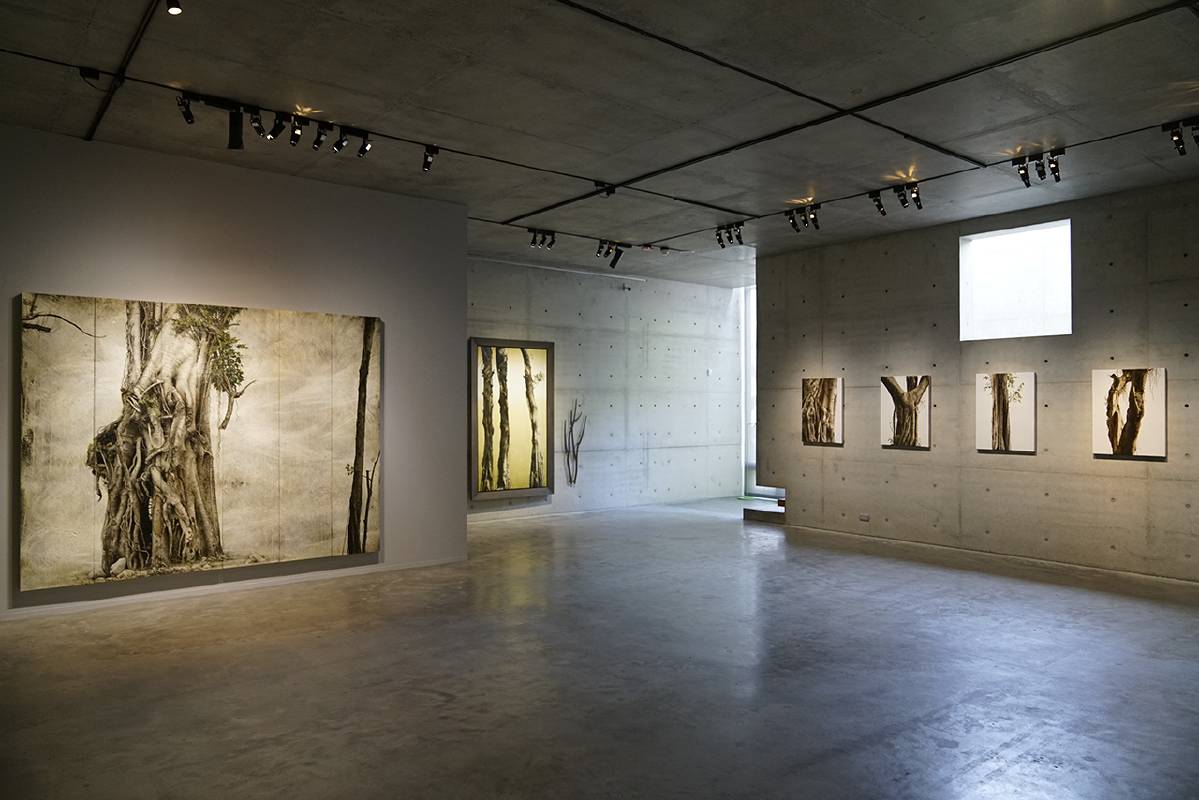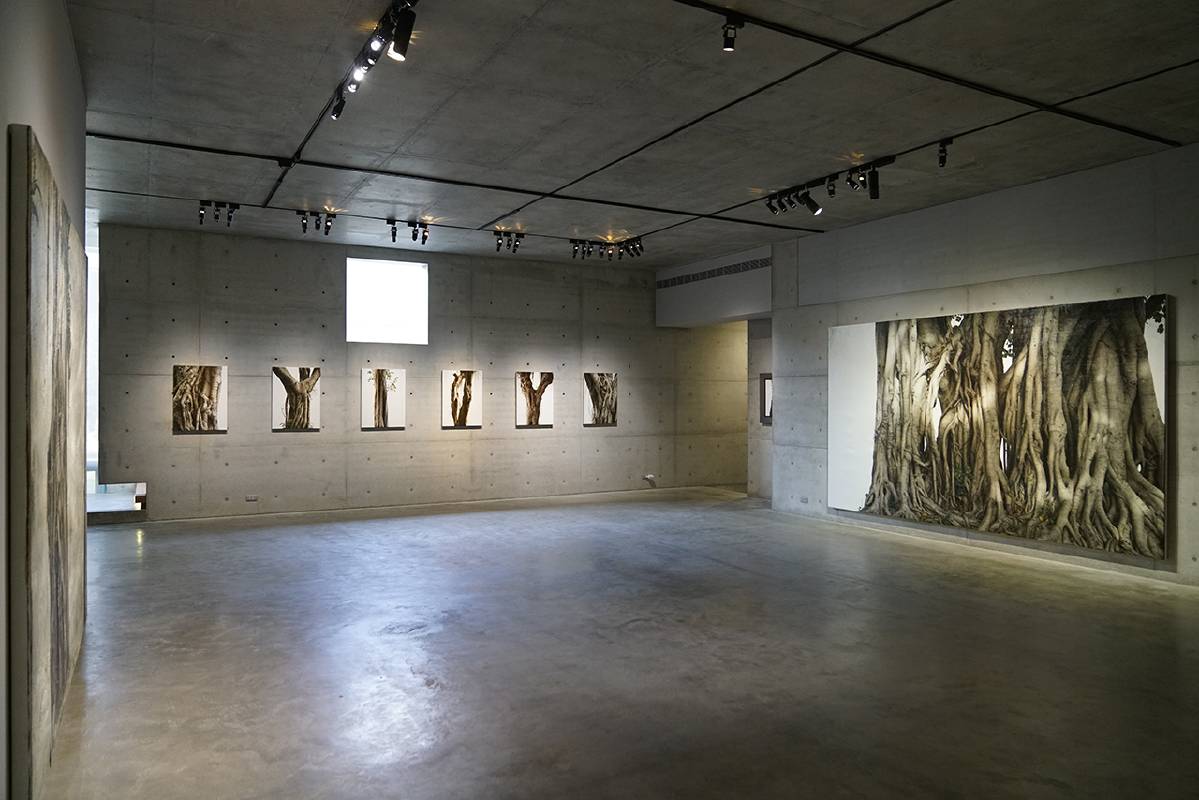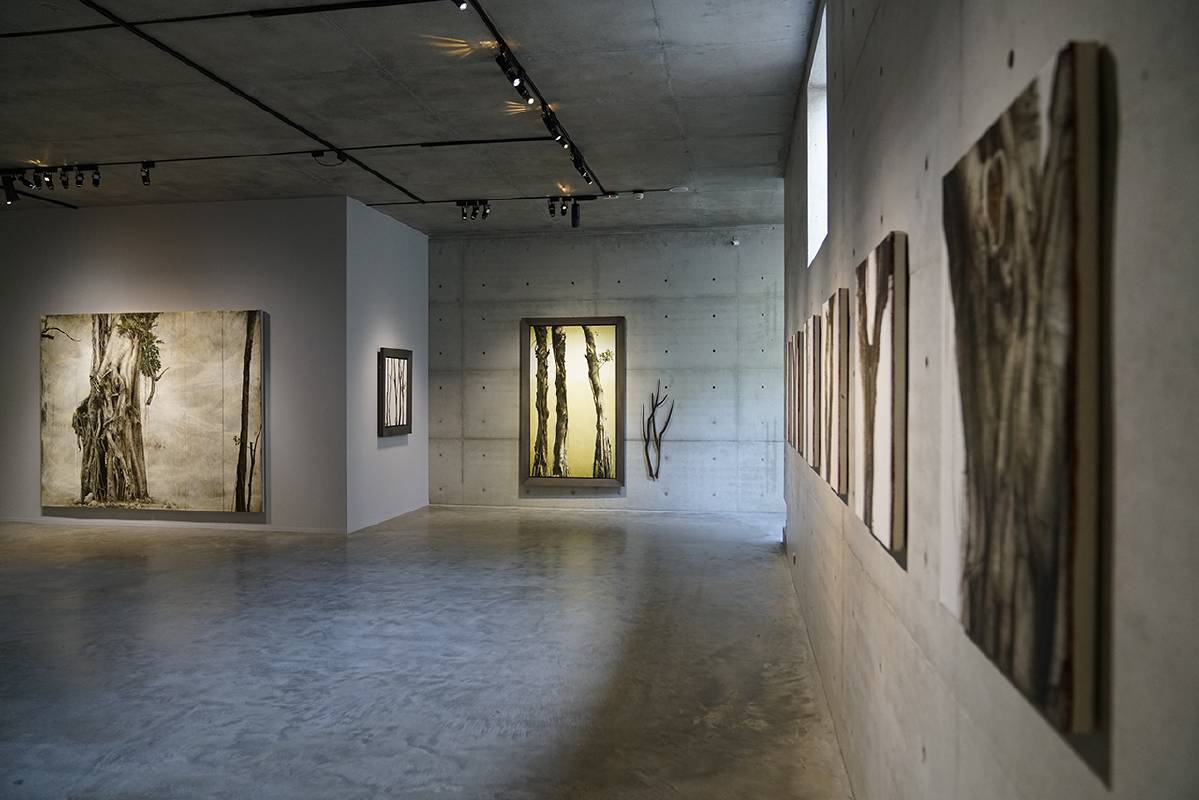采泥藝術
【毓繡美術館近山─何以為界】

-
展期
日期:2021-01-30 ~ 2021-06-13
-
地點
草屯鎮健行路150巷26號(毓秀美術館)
-
參展藝術家
陸先銘、洪天宇、林煒翔
-
陸先銘三十多年來的創作內容,一直鎖定生活環境中所糾結的文化省思,希望藉著不同時期的人文觀察、心境變遷、研究角度,依序勾勒出台灣社會底層某種堅實特殊的文化造形,而以創作積極介入社會脈動,落實在地人文關懷,並延伸到歷史詮釋和時代觀照。
陸先銘此次所展出的「老樹時期」系列新作,從早期尖銳批判的直接強悍,在構築蛻變之際,注入更多人性關懷與情感內涵的創作轉向;該系列作品是藝術家回歸生命本質,透過環境生命的再詮釋來傳達人類文明與自然環境之間應尋求的和諧存在與價值。
毓繡美術館2021年首檔聯展「近山─何以為界」陸先銘、洪天宇及林煒翔的作品,以各自關注的題材鋪陳情景。我們將由身體的攀升,感受視線所及與心理狀態的轉變,視角的遠近拉距也從平實明晰、繁複精細漸進至抽象流動。我們在挪移身體之時,山林的細膩情感、社會角色、生命力量,以及人類對自然的牽扯和嚮往也就順流顯現而出了。
[展覽介紹]
自然,一直存在於我們認知上的周遭,但似乎又顯得相當陌生,當想靠近的時刻又顯得不知所措,此時我們該用何種姿態親近祂呢?
我們該如何靠近自然?在早已不知何以為界的時代,如今提出這個問題,似乎是愚笨的。古代人懼怕僻遠之地,原住民相信山林擁有靈魂,因而入山前總有特定儀式以茲感謝、以茲保安,這是他們靠近自然的方式。人類進入山林的歷史極早,登山運動源於18世紀末的歐洲,台灣群山則在日治時期才由日籍學者首次進行探勘,不過國內登山活動直到70年代才起而流行。人類入山的理由千百種,反映出對於未知領域的好奇與憧憬。
此展的山是廣義的,泛指自然萬物,凝縮我們日常觸及的生態物象。將靠近一詞置於不同時代下解析,會發現語境早已和當初不同,並非單純意味身體力行,滿足於挑戰登高或一探究竟,而是夾帶更深厚的政治性、消費性和自我中心主義,而美好景緻就這樣隨人類的慾望需求,被操勞消耗數十年。即使當今環保意識廣泛普及,然而當疫情遍地流行、反覆發作,限縮了人類於空間遷移的自由,似乎有種召喚告訴大夥該趨向山林了。如何靠近自然的提問或許過時,靠近的方式確是無盡,更多是談論、詮釋、包裝、想像,從而擠壓塑造出人類世的獨特景觀。在這萬事講求壁壘分明的社會,自然與文明的疆界則是越趨混沌。
本展陸先銘、洪天宇及林煒翔的作品,以各自關注的題材鋪陳情景。我們將由身體的攀升,感受視線所及與心理狀態的轉變,視角的遠近拉距也從平實明晰、繁複精細漸進至抽象流動。我們在挪移身體之時,山林的細膩情感、社會角色、生命力量,以及人類對自然的牽扯和嚮往也就順流顯現而出了。
[藝術家介紹]
陸先銘1959年生於台北,1982年畢業於中國文化大學美術系,大三即獲雄獅美術新人獎,1985年退伍後在台北嘉仁畫廊開了首次個展。自80年代末期,陸先銘即活躍於以文化大學美術系為主的台北畫派和悍圖社;1984年擔任華岡現代藝術協會會長、山風藝訊主編;1992年台北畫派會長;1995至2018年於台北視覺藝術協會擔任總幹事等不同職務;2003至2007年皆為悍圖社社長。1979至1987年間,陸先銘的創作心境與風格皆產生轉折,不僅歷經就學、兵役與步入社會,當時台灣的解嚴與經濟、民生等各方開放、環境的劇變更對他影響甚深,令其作品從生澀清冷轉為批判與剛烈。幾個創作系列如《陸橋》(1991-1996)、《人物》(1995-2007)、《城市劇場》(2007-2016)以及2017年開始的《老樹時期》;從自己的生存困境、城市的工業性格、底層人物,到近年回歸對自然和生命的關切,陸先銘的作品始終圍繞在人身上,或藉由物的構建映射出人類的處境。畫風從猛烈的情緒走向理性情感,考量不同情境目地呈現出多元技法,後期更配搭金屬等不同質地媒材,衍生出半裝置形式的藝術創作。作品曾至日本、韓國、中國、蒙古、新加坡等地聯展,收藏機構包括台北市立美術館、國立台灣美術館、高雄市立美術館、台東美術館、澳洲雪梨白兔美術館及上海龍美術館。
[Exhibition Introduction]
Nature has always existed around us. However, it has always been rather distant and strange to us as well. Whenever we hope to be near nature, we seem to be at a loss. At such a moment, how do we approach nature?
How do we be near to nature? In this era when boundaries seem to have dissolved, this question might sound somewhat redundant. The ancient people feared remote places; moreover, the indigenous people have always believed that mountains have a soul and would perform specific rituals to express gratitude and seek protection. This is how indigenous people approach nature. In history, humans entered mountains at a very early period. Mountaineering originated in Europe at the end of the 18th century; and the mountains in Taiwan were investigated for the first time by Japanese scholars during the period of Japanese rule. Yet, mountaineering in Taiwan did not become popular until the 70s. Humans go into the mountains for many reasons, which all reflect our curiosity about and longing for unknown places.
This exhibition refers to mountains in a broad sense and uses them as a metaphor for nature and all life in the ecosphere that we might come into contact in the everyday life. “Being near” means varied things in different times, and the context today has changed greatly from that of the past. Being near to mountains does not simply mean a physical activity that denotes a challenging trip of mountaineering or an adventurous expedition. Instead, it carries deeper implications of politics, consumerism, human-centrism, as well as how breathtaking landscape has gradually been wasted and depleted by human desires in the past decades. Today, environmental awareness is already widespread. However, when a pandemic is now sweeping through the world and recurs in a way that has extensively limited us to move freely, something seems to be calling us to revisit the mountains. The question about how we can be near nature might be somewhat outdated, but the ways to approach nature are numerous. Regarding this topic, there are even more discussions, interpretations, marketing and imagination, which have mixed and shaped the distinctive landscape of the Anthropocene. In this society that demands clear division of everything, the boundaries between nature and civilization have instead become more and more indistinct.
This exhibition features works by Lu Hsien-Ming, Hung Tien-Yu and Lin Wei-Hsiang, who focus on different subject matters to delineate and represent natural landscape respectively. In the exhibition, as we physically go higher and higher, we will see the changing line of vision and state of mind. As the viewpoint shifts from close to distant, the images also move from visually distinct, to elaborately minute, to abstractedly fluid. As we physically move through the exhibition, the delicate feelings towards mountains, their social role, the force of life and human’s entanglement with and longing for nature will be naturally revealed.
[About the Artists]
Lu Hsien-Ming (b. 1959-) was born in Taipei, and graduated from the Department of Fine Arts, Chinese Culture University (CCU) in 1982. When he was a junior in college, he was already awarded the New Talent Award of Hsiung-Shih Fine Arts. After completing military service in 1985, he held his first solo exhibition at Chia Jen Art Gallery. Since the end of the 80s, Lu has been an active member of Taipei Art group and Hantoo Art Group, of which the members were mainly CCU art graduates. In 1984, he served as the chairman of Huagang Chinese Modern Arts Society and the editor of Mountain Wind Art News. In 1992, he became the chairman of Taipei Art Group. From 1995 to 2018, he served various positions, including the executive secretary of the Taipei Visual Arts Institute. From 2003 to 2007, he was the chairman of Hantoo Art Group.
Between 1979 and 1987, a turn in Lu’s creative state of mind and style was visible. During this period, he graduated from college, finished military service and began his artist career. It coincided with a period when Taiwan’s martial law was lifted and the economy and society became more open. The drastic social changes had a great impact on him, and his work gradually shifted from being inexperienced and cold towards critical and intense. Such a shift could be observed in several of his art series, including Bridge (1991-1996), Figures (1995-2007), Urban Theater Period (2007-2016) and Old Trees Period starting in 2017. Throughout these series, Lu has begun with his own struggles in life, and moved to the industrial characteristics of cities and people from the low social stratum before eventually returning to the subject of nature and life in recent years. In spite of these changes, his work has always revolved around people or the human condition reflected in his construction of objects. His painting style has evolved from strongly emotional to affectively rational, depicting different situations and purposes with diverse techniques. In a later period, he has also added materials of varying texture, such as metal, to create semi-installations. Lu’s works have been exhibited in Japan, Korea, China, Mongolia, Singapore, etc., and are included in collections of numerous art institutions, such as Taipei Fine Arts Museum, National Taiwan Museum of Fine Arts, Kaohsiung Museum of Fine Arts, Taitung Art Museum, White Rabbit Gallery in Australia and Long Museum in Shanghai.
推薦展覽
view all采泥藝術
【微觀知覺 ─ 蔡孟閶、梁海莎、川人 綾】Micro-Perception: TSAI Meng-Chang, LEONG Hoi Sa, Aya Kawato
日期:2024-08-10 ~ 2024-09-22|台灣,台北市










